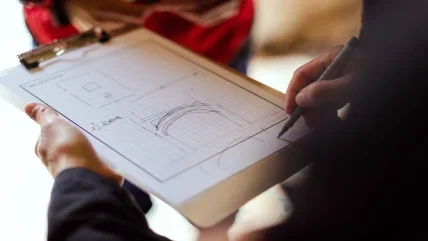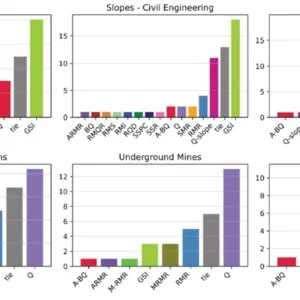
With just one click you can download a teaching pack produced by the British Tunnelling Society Young Members (BTSYM) that covers a wide range of subjects related to tunnelling and design.
Targeted at students from 11 to 17 years old, the pack consists of five lessons, which span from an introduction to tunnelling to design consideration, tunnelling techniques and geology. The pack links to subjects the students are already covering, for example geography.
“The fifth lesson offers students the chance to complete a project, for example to design a tunnel in certain geological conditions in an urban environment,” says Gerard Quigg, senior civil engineer at Cowi UK and chair of the 2017 BTSYM Schools and Universities (S&U) committee. “Students use the knowledge developed over the previous four lessons to propose a solution.”
Quigg explains that his involvement in the teaching pack started in November 2016. “Following a contact made by one of our members at the 2016 Big Bang Fair, the BTSYM arranged to trial the existing Teaching Pack at the Oasis Academy, Southbank. We met with the module leader and developed two 12-week lesson plans, based around our five-lesson Teaching Pack.”
“During the first term, from January to April 2017, the BTSYM S&U committee members led each session,” Quigg says.
This entailed preparing for each lesson, giving presentations at the school, organising visits to site and the Institution of Civil Engineers (ICE) and preparing additional lesson plans based on the recent tunnelling documentaries.
During the second term, the teacher led each lesson with one BTSYM committee member present to assist. The BTSYM continued to arrange site visits and activities with the students during the term. “Throughout the trial we wanted to see if the pack is easy to understand for students and teachers who are not from a tunnelling or engineering background.
The main challenge was to make it accessible especially for teachers as we didn’t want to create extra work for them in their already busy schedule. We added notes for each presentation, an outline lesson plan for the teachers and some further information if the teachers want to do some extra research. The feedback was so good that the school decided to use the Teaching Pack again this year.” Oasis Academy module leader Sarah Martin said: “The level of detail was immense and made it a project that stretched even the most able of students.
The presentations were thoroughly thought out and contained extensive notes for the classroom teacher to ensure they were able to deliver the content. The speakers who came to speak with the students were engaging and enthusiastic about tunnelling. My favourite highlight of the BTSYM ‘experience’ was the site visits to the Northern Line Extension at the Battersea Power Station. At the ICE tunnelling exhibition the students ran around the room wanting to learn more about the Tideway and Crossrail projects.”
During the trial, the BTSYM also ran a competition at the Oasis Academy to name a TBM on a local project. Students were tasked with writing a short paragraph summarising why their chosen name was significant in the Science or Engineering industry within the UK. The students were divided into groups of 2-3 and the BTSYM received 10 entries. The winning entry was Maggie Aderin-Pocock an English space scientist, so the TBM was named ‘Maggie’.
The winning students were invited to site for the naming ceremony in January 2017. The students received a tour of the site and spent the day shadowing the Engineers.
Quigg adds: “This competition was relevant to one of our activities on community engagement, trying to make students aware of the importance of local community engagement”.
The teaching pack has been launched on the BTS website as well as the re-branded ICE website, which has a re-developed Education section. In the section for the age group 11 to 17 there is the link to the Teaching Pack.
“In November 2017 we ran a competition at the ICE Tunnelling Exhibition” Quigg says. “We worked with the ICE Graduate and Students Group and students had to design an innovative underground space. During this event we had the opportunity to promote the Teaching Pack to the schools that attended. We are also trying to encourage use of the pack within some of the current large scale projects and by contractors. For example, we have been contacted by High Speed 2 and Thames Tideway to explore working together with their Education teams. We would like to promote the pack as an extra resource for contractors and consultants to use on any community engagement projects with local schools.
“The idea is that schools can go online, download the pack and use it themselves,” Quigg says.
The long-term goal is for the pack to be standalone. The development of the pack was a voluntary project that BTSYM carried out during their spare time after work and over the weekend. Since the BTSYM was set up in 2008, the S&U committee have developed the pack into a valuable resource, trialled it and engaged with a number of schools – the pack is now ready to be used. If teachers are interested in arranging site visits, the BTSYM contact details are provided on the website. The BTSYM understand that other young member committees, including The International Tunnelling Association (ITA) Young Members Group, are also starting to develop a teaching pack for use in other countries.
Tunnel Engineers of the Future
“One of the main challenges in getting students into the tunnelling industry is to make them aware of what we do,” Quigg says. “Sometimes when people are asked what engineers do, they might think that we drive a train or fix washing machines. It’s relevant to explain who engineers are and what we do. Of course it can be difficult to explain the technical challenges of tunnelling to a new audience, and we hope the teaching pack will aid with this over the coming years.” Students showed their interest in the tunnelling industry over the course of the trials.
“Over the last couple of years, TV documentaries have helped the general public, and the younger generation in particular, to understand the tunnelling world. Many students have a working knowledge of tunnelling projects – such as Crossrail. We were impressed that students knew what the tunnelling industry is and the type of tunnel boring machines, as well.”
Talking about the increased focus on IT jobs, Quigg explains that this can also be applied to the tunnelling industry and used to encourage younger engineers to join the industry.
“Children today grow up surrounded by IT. When we explained that the tunnelling industry regularly uses 3D printed models, augmented and virtual reality – the students were impressed and could see the industry in a different light”.
The BTSYM Teaching Pack is now available to download from the British Tunnelling Society website






